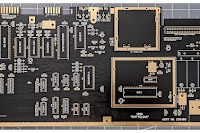"J-CIA is finally here!
After a long wait, J-CIA is finally released!
The released version ("J-CIA64") is only compatible with 6526/8521 - CIA.
Amiga compatible version will be released later."
So what does the J-CIA64 actually do? Unlike the ARMSID and the VIC-II Kawari there's no software configuration for the J-CIA, and it brings no additional functionality, or for that matter, complication and is very nearly nearly as simple as plug and play. It's just a replacement CIA (Complex Interface Adapter). And I'm glad it's finally here.
Let's take a closer look:
 |
| Click for an extra large image (may take a few moments to load) |
Printing on the ICs isn't crystal clear so thats an iCE40 Ultra™ Lattice FPGA (ICE5LP1 SG48I) sitting on top and four NVT2010 bidirectional voltage level translators to complete the IC collection.
Now here's something of interest: the included instructions advise us we can change mode between 8521 "new" and 6526 "old" CIA by soldering this jumper:
 |
| We can solder this jumper, but should we? |
"later C64-versions may also use the 6526A or the 8521."
As pictured, the J-CIAs are delivered configured for the new CIA variant, the 8521, with a simple solder jumper to configure for the old, the 6526. So the question we must ask, is do we need to solder that jumper?
To answer that I guess we need to know the difference between the old and new variants.
According to Eslapion in this forum post:
"The 8521 is just a HMOS version of the 6526 which dissipates less heat. They are mostly identical from a software and electronics point of view."
Now, I suspect the word "mostly" in that sentence is doing some heavy lifting, otherwise why would Jani give us the ability to choose? That said, Jani's own site states:
"Usually, the mode doesn't need to be changed, most software and hardware are designed to work with both versions."
Eventually, however, I did stumple upon a more comprehensive answer, purportedly from Jani:
"It selects selects/enables different pieces of logic at the core. There is small differences in logic between 6526 and 8521. Timing and everything is the same. I mean bus timing is the same. But, in some cases there is for example 1 cpu cycle difference in timing between 6526 and 8521.”
Make of that what you will. So, for the time being, and because I can't trace an official (from Commodore) list of differences (or any list of differences at all), take the path of least resistance and simply install as is.
 |
| What a magnificent pair! |
At €39.95 each these don't come particularly cheap, and when you've factored in shipping from the Netherlands to Scotland, security fees, Paypal fees and "transaction costs" (whatever that is) my wallet took a €90.71 hit for the pair (81.16 GBP or 100.02 USD) from retro8bitshop. However, consider the time and investment Jani has made to make these available. A not inconsiderable amount of money and brainpower is required to develop something like this. Accordingly, I have no problem at all shelling out this sort of sum, not least to help support the developer.
If you decide these are for you, please see the Installation Guide and Disclaimers at Jani's website.





